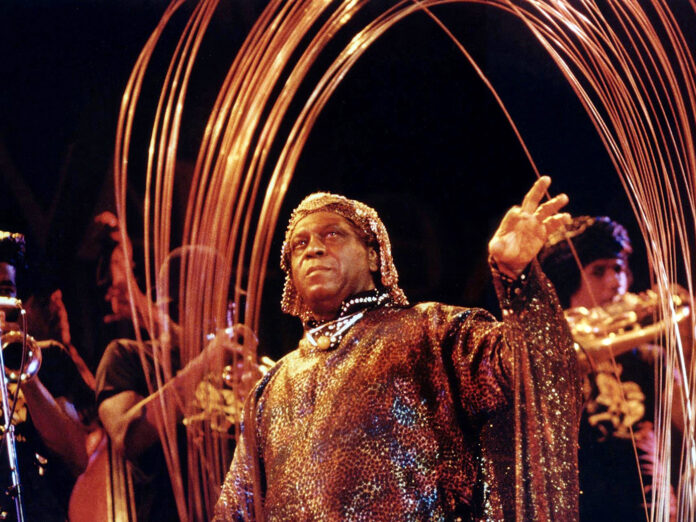Originally published in Uncut's February 2016 issue Subscribe to Uncut and make huge savings on the cover price - find out by clicking here! How the interstellar pioneer of free jazz created a mystical, Afro-futurist epic as a gift for the Creator: "He was the most unusual person…" ____________...
ALLEN: You didn’t have no time for yourself no more, to do other things, you know. But that’s the way it is. He had so many ideas and he didn’t want to miss none of them, he’d write them down and off we go, all day long, half the night, take a break, eat, and then go back at it. You still had to rehearse every day on the road. Riding the bus, you get tired – then you’re gonna have a rehearsal, haha. Then you wanted to relax, but you gotta rehearse. You just lived the music. I got a stack of music as tall as I am, and that’s just my parts! Yeah, he was strict, because he needed discipline and he needed precision.
THOMPSON: The neighbours had gotten used to us. In fact, one next door neighbour had children there, she had five girls. And one of them told me later, “We grew up, we did our homework, we did everything to Sun Ra’s music.”
WILMER: The basis for Sun Ra’s music was very different to what Miles Davis was doing, for example. Sonny was making them do something else, and lot of the things they played are much more intricate.
THOMPSON: We played “Space Is The Place” for about six months or something before we recorded it. Our bass players usually lived in New York so they couldn’t come down all the time for rehearsal. So for most of the bass parts for these songs, Sonny had me play them on baritone sax. He wrote “Space Is The Place” in 4/4, but the bass part is in 5/4 – don’t ask me how it fits, it just fits. He wrote that bassline for me.
ALLEN: We recorded “Space Is The Place” in Chicago, and it was one of the first records with all the girls singing. It was a long one, you know! We were hitting a groove, so it just went on. They had to fade out on it, it was so long.
THOMPSON: Sun Ra would direct tracks while we were in the studio, he’d point to somebody and we just played intuitively. We didn’t overdub. On “Space Is The Place”, it was straight down, it was what you hear. We had all our dancers and we had just come back from Ann Arbor Jazz & Blues Festival, then we went to Chicago and recorded the song. On a recording session Sun Ra would tell [the engineers] to turn the tape on and keep moving. But that time the guys never did turn the tape on. So we played it and I thought we were recording it. It’s a very long song, 22 minutes, I think. So we played it once and found out that they didn’t turn on the tape. I’m like, “Oh boy, here we go again”… but the music is so energising that it didn’t make any difference. So we did the second take, and it was 22 minutes long again. After it stopped, Sun Ra was like, “Yeah, that was it, that was nice.” You should’ve heard the first take. You think the second take was something – the first take was really something.
SCOTT: There are certain types of Sun Ra songs that are mantra songs, it’s the only way I can explain it. But it’s not an Egyptian or Indian mantra thing, it’s an African-American mantra thing that goes back to the church. Musicologically speaking, “Space Is The Place” comes from the gospel shout. That’s why all the best bands came from the South, ’cause they all came out of the church, and that feeling went into the music.
THOMPSON: The Space Is The Place movie took about six or seven months to make. It was a regular film with actors and everything, you know, the cameraman, all kinds of stuff, a director. Sun Ra didn’t have a script though, he didn’t want a script. Anything you heard Sun Ra say, it was coming from his spirit.
SCOTT: Space Is The Place was Sun Ra’s solution for the problems African-American people were experiencing over 400 years over here [in America], that the Nubians of ancient Egypt had experienced away from their earthly home, which was Egypt, and away from the place where they originally came, our original planet Sirius B. And if you look at the cosmology of the Dogon as well as the mathematics within the Pyramids, many of those were built so at a certain point in time the light from Sirius B will shine down on a certain spot – it was calculated and it’s all documented. So Space Is The Place really dealt with those concepts, but in a simplified form.



